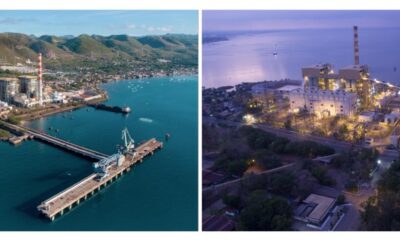Lifestyle
The Top 15 Richest Countries in the World


The Gross Domestic Product, also known as GDP, is a measurement of a nation’s wealth that includes income, consumption, and the value of the goods and services the nation generates over the course of a year. A useful metric that can provide light on a nation’s standard of living is the GDP per capita, which is calculated by dividing national wealth by the total population. The wealth and prosperity of the nation’s citizens can frequently be determined by the GDP per capita, which should be high.
Here is a list of the top 15 richest nations in the world according to their GDP per capita in PPP terms (Purchasing Power Parity).
01. Luxembourg
Population: 625,978
GDP per capita (PPP): $140,694
Luxembourg is the richest nation in the world, distinguished by high-income levels and a low unemployment rate. While its wealth remains constant, its inflation rate increased to 6.8% in August 2022. The developed infrastructure and high labor market values draw investment and clones of the major outside companies. Nowadays, Luxembourg benefits from a variety of businesses, primarily from an import-export economy built on financial services, and by having one of the most educated workforces in the world. The nation also has a modest but thriving agricultural sector.
02. Singapore
Population: 5,850,342
GDP per capita (PPP): $131,580
The hard-working and resourceful Singaporeans have managed to make their nation the second-richest in the world despite the lack of natural resources on which to base its economy. The nation’s primary exports include electronics, biotechnology, and chemicals, and the positions in manufacturing, services, transport engineering, and logistics pay highly for its workers. Singapore draws millions of tourists each year by building upscale infrastructure and greatly growing its tourism industry.
03. Ireland
Population: 4,937,786
GDP per capita (PPP): $124,596
Numerous multi-billion dollar businesses are continually drawn to Ireland by its low corporate taxes, where they can expand and contribute to the country’s GDP and high level of living. Others long for the stability of the nation and the steady flow of income from manufacturing, agriculture, and tourism. Metals and food goods, including beer, computers, components, and software, as well as textiles make up the majority of the nation’s exports.
04. Qatar
Population: 2,881,053
GDP per capita (PPP): $112,789
The once-sleeping peninsula off the eastern coast of Saudi Arabia has transformed in the last 20 years from a little fishing sector and nearly no schools to a significant oil-exporting international center. With reserves of almost 900 trillion cubic feet, Qatar boasts the world’s greatest natural gas reserves, surpassing Iran and Russia. This resource accounts for 60% of Qatar’s total GDP. It started producing 46,500 barrels per day in 1951 after finding oil in 1939 and natural gas in 1983. After becoming independent in 1971, Khalifa bin Hamad overthrew his father and reduced the allowances given to the Royal Family while increasing spending on social programs, housing, healthcare, education, and pensions. The nation gains large returns through investments in international companies, banks, Paris Saint-Germain soccer team and London real estate.
05. Switzerland
Population: 8,654,622
GDP per capita (PPP): $84,658
In Switzerland, one of the happiest and healthiest countries on the planet, people who speak German, French, and Italian coexist harmoniously and successfully for more than 800 years. Switzerland is considered highly by investors looking for a secure refuge for extremely lucrative endeavors because of its steady economy and fixed currency value. Investment is attracted by Switzerland’s attractive tax rates, and foreign businesses are looking to develop there as well.
06. United Arab Emirates
Population: 9,890,402
GDP per capita (PPP): $78,255
From the 1770s, when this nation was still known as the Trucial States, until the late 1930s, when pearl-diving was a hobby transformed into a sizable source of revenue for the people living in the little villages, the pearl industry predominated in this nation. Dubai and the rest of the nation have moved on to tourism, which keeps investing in itself through continued growth and appeal, after being able to create some of the most opulent resorts in the world. After oil was discovered in the late 1950s, residents of Dubai and Abu Dhabi clashed, with the latter winning the oil war and prospering while the former struggled.
07. Norway
Population: 5,421,241
GDP per capita (PPP): $77,808
With its excellent educational systems, distinctive social security system, and universal health care, Norway is renowned for having the best standard of living on Earth and ranking first on the human development index. Its raw oil and gas exports drive the economy, and a wealth of reserves—including those for freshwater, minerals, lumber, hydropower, seafood, and hydro—ensures future success. While parents make sure that children understand the value of productivity at school from an early age, the government invests in providing free education for its citizens. In Norway, staying active at work is a cultural requirement; without it, people would not enjoy life.
08. United States
Population: 331,002,651
GDP per capita (PPP): $76,027
The United States has the largest economy in the world and a land that is resource-rich, giving it a strong purchasing power. In America, entrepreneurship is promoted from a young age and is backed by academic curricula and research organizations. The scale of its economy and the high pace of real GDP growth are unmatched by any other nation, and it supplies its own energy and can profitably export its oil and gas. Although these statistics entice brilliant individuals from over the world to try their luck at becoming wealthy, it continues to rank among the top nations where money is not distributed fairly.
09. Brunei
Population: 437,479
GDP per capita (PPP): $ 74,953
The little nation of Brunei, located in South Asia, quickly expanded to become one of the richest nations in the world after gaining independence from Britain in 1984. Given that the wealth in the country is not divided fairly and a large portion of the population lives in poverty, it may come as a surprise that Brunei is regarded as the second-happiest country on the continent after Singapore. The offshore oil drilling business, which generates economic wealth through export, is what has made Brunei so wealthy. It is commonly known that a significant portion of the population in Brunei owns an automobile, which is more than the average for the world.
10. San Marino
Population: 33,931
GDP per capita (PPP): $70,139
San Marino was formerly a nation of farmers and stone quarries that produced cheeses, other agricultural products, and distinctive souvenirs made of stone. These days, the nation’s hard-working residents support the economy by making ceramics, tiles, furniture, building supplies, paints, premium spirits, and wines for export. The recent economic expansion of the country has also been influenced by the export of fruit. Through the Italian economy, including its monetary and customs institutions, San Marino’s banking system is likewise tightly intertwined with that of the EU. Last but not least, despite a low local population and a decline in visitors to 2 million per year, tourism still accounts for more than half of the nation’s GDP.
11. Denmark
Population: 5,792,202
GDP per capita (PPP): $69,273
Denmark’s national economy ranks 35th in the world in terms of nominal GDP. The diversified economy of Denmark, which has a population of approximately 5,792,202, is deservedly sustained by the high standard of living, reliance on imports and exports from outside, and an enhanced level of governmental services and income transfers. Construction, medical and transportation equipment, food manufacturing, wind turbines, and other important industries are just a few that Denmark is home to. Fish, meat, dairy products, pharmaceuticals, machinery, crude oil, and other goods are the principal exports of the nation.
12. Netherlands
Population: 17,134,872
GDP per capita (PPP): $68,572
The Netherlands’ thriving and open economy is largely dependent on foreign commerce, low rates of unemployment and inflation, stable industries, and the nation’s important position as Europe’s principal transportation hub. The Netherlands has a number of important sectors, including refining petroleum, food processing, financial services, electrical machinery, etc. The Netherlands is also a major exporter in the world. The Netherlands’ economy was recognized as the fourth most competitive economy in the world in a 2018 survey by the World Economic Forum.
13. Austria
Population: 9,006,398
GDP per capita (PPP): $64,751
Austria is one of the richest nations in the world in terms of GDP per capita because of its highly advanced social market and industrialized economy. International tourism is one of the main drivers of Austria’s economy in addition to its highly developed industry. Austria’s trade with other EU members accounts for well over half of both its imports and exports.
14. Iceland
Population: 341,243
GDP per capita (PPP): $ 64,621
Tourism, manufacturing, aluminum smelting, fisheries, agriculture, etc. are a few of Iceland’s key industries. Iceland’s mixed economy primarily depends on governmental intervention as well as increased levels of free trade. The nation now produces the most electricity per capita in the world because of the usage of geothermal and hydroelectric power. Iceland is now among the world’s top greenest economies as a result of it.
15. Andorra
Population: 77,265
GDP per capita (PPP): $63,600
Andorra, a nation in southern Europe, recently surpassed Germany on the list of the world’s 15 richest nations. With a population density of roughly 169 people per km2, it has one of the lowest populations and is one of the smallest countries in the world. Its area is only 470 km2. In terms of nominal economic size in 2020, Andorra was ranked 165th, and its national debt was $1,337,000,000, or 46.33% of GDP.
































